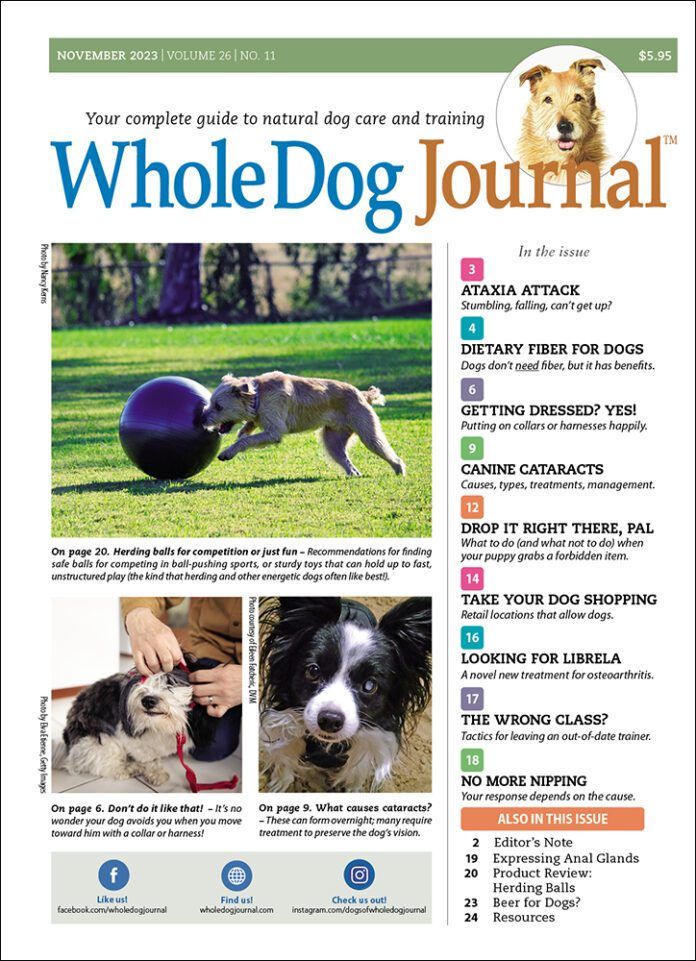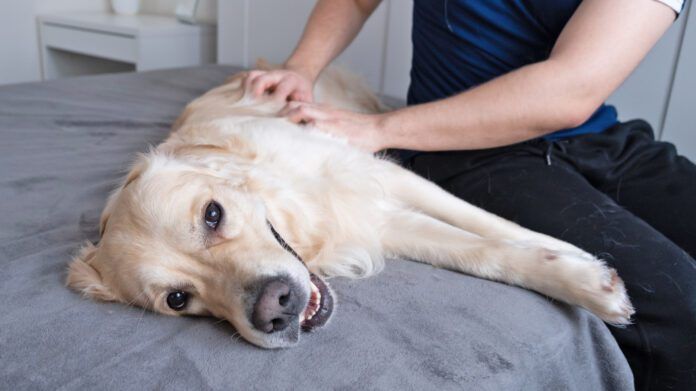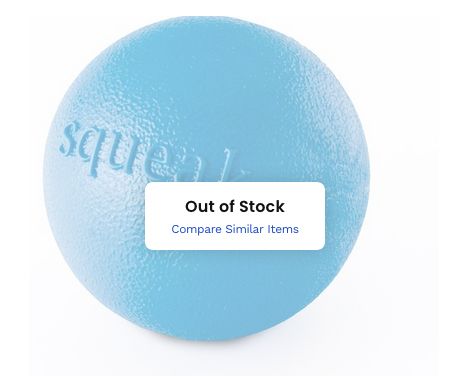- Ataxia Attack
- Dietary Fiber For Dogs
- Getting Dressed? Yes!
- Canine Cataracts
- Drop It Right There, Pal
- Take Your Dog Shopping
- Looking For Librela
- The Wrong Class?
- No More Nipping
Download The Full November 2023 Issue PDF
Xylitol Poisoning
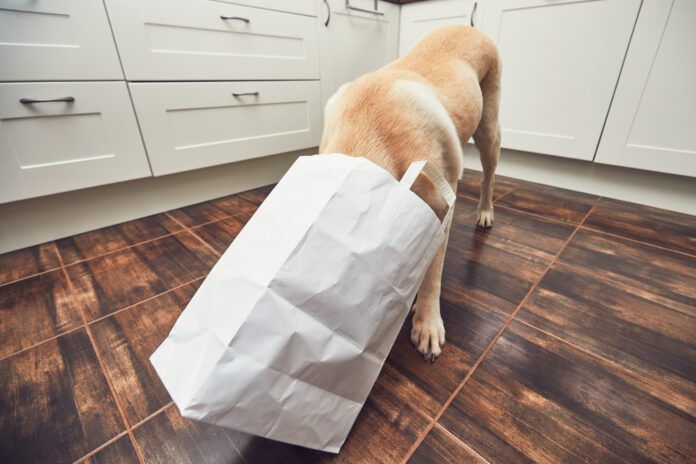
You’re picking up the bag you left by the front door only to discover that the tub of sugar-free gum you keep in your bag is laying on the floor, emptied of its contents. Your dog is sitting nearby with conspicuously minty breath. A flood of panic comes over you – and it should, because if that sugar-free gum contains xylitol, your dog may be at risk of dying from xylitol toxicity.
The symptoms of xylitol poisoning can start within 20 minutes. Signs include:
- Vomiting
- Decreased activity level
- Weakness and collapse
- Difficulty walking or standing
- Shaking or seizures
- Coma
- Liver failure
- Bleeding problems
Xylitol is a sugar substitute known as a sugar alcohol. It can be found in many different household items toxic to dogs. Including sugar-free gums and mints, adult and children’s chewable vitamins and supplements, baked goods, mouthwash and toothpaste, cough syrup and other liquid medications, and even some brands of peanut butter.
How xylitol affects dogs
Xylitol stimulates a dog’s pancreas to produce large quantities of insulin. Insulin is the hormone that allows glucose (sugar) to be taken up from the bloodstream and into the body’s cells. A sudden large influx of insulin causes so much glucose to be taken up by the cells in a dog’s body that his blood glucose drops to dangerously low levels. This is known as hypoglycemia.
Hypoglycemia from xylitol ingestion can occur quickly, often within the first 10 to 15 minutes of ingestion. Low blood sugar can cause ataxia (wobbly gait), vomiting, tremors, weakness, and seizures. Untreated xylitol ingestion can progress to coma and death.
Xylitol can also cause liver damage when ingested in high quantities. Dogs with xylitol-related liver damage may develop difficulty clotting. This can cause bruising and internal bleeding.
Treatment for Xylitol Poisoning
If your dog has ingested xylitol, your veterinarian will recommend that your dog be hospitalized on intravenous fluids. He will need to receive intravenous dextrose (a form of sugar) and have his blood glucose levels monitored every two to four hours. Dogs who have ingested xylitol are typically hospitalized for 24 to 48 hours until they are able to maintain a normal blood glucose without dextrose supplementation.
Dogs who develop xylitol-induced liver damage require more intensive care. They often require one or more transfusions of fresh frozen plasma – a blood product that contains proteins and clotting factors but not red blood cells – to replace the clotting factors their livers are not able to produce. They also are given medications to help support and protect their livers from further damage. Dogs with xylitol-induced liver damage are typically hospitalized for three to five days and sometimes longer, depending on their response to treatment.
If your veterinarian is not able to provide round-the-clock care for your dog, she may recommend that your dog be transferred to an emergency and critical care hospital. Upon transfer, your dog will be hospitalized in an intensive care unit in order to receive continuous monitoring and dedicated nursing care.
Dogs who receive quick intervention and appropriate treatment for xylitol ingestion have a good chance of a fast recovery. Dogs who develop xylitol-induced liver damage will have a prolonged recovery that may require medications and follow-up bloodwork for a month or more following discharge from the hospital.
You just found an empty tub of sugar-free gum on the floor. Don’t panic! And follow these steps to ensure the best for your dog’s health and safety:
- Look at the ingredient list on the label. If xylitol is listed, proceed to step 2. Otherwise, breathe a sigh of relief and hug your dog.
- Do not induce vomiting at home with hydrogen peroxide unless directed to do so by a veterinarian. Hydrogen peroxide has been shown to cause inflammation of the esophagus and stomach ulcers in dogs. Your veterinarian can induce vomiting with a much safer and more effective drug.
- Call ASPCA Poison Control at (888) 426-4435 and take your dog to your veterinarian or the nearest emergency hospital immediately.
- Upon arrival at the veterinary hospital, tell the staff what and how much your dog ingested, the poison control case number you have been provided by ASPCA Poison Control, and any medications your dog is taking or medical conditions he has.
- Your veterinarian will induce vomiting to recover as much of the gum as possible. On average, only about 60% of ingested product is recovered from vomiting.
- Your veterinarian will contact a toxicologist at ASPCA Poison Control using the case number you provided and formulate a treatment plan specifically for your dog.
We know that xylitol is toxic to dogs. So why do I need to contact poison control if my dog has ingested a product containing xylitol?
Although xylitol may be in a product’s ingredient list, the amount of xylitol is not specifically listed on the label. You may notice an entry for “sugar alcohol” on the nutrition label. Most products that contain xylitol also contain other sugar alcohols, like maltitol and sorbitol. These are not toxic to dogs but are included in the total gram count of sugar alcohols on the label. This means that we cannot rely on the amount of sugar alcohol on the label to tell us how much xylitol a product contains.
The amount of xylitol a product contains can vary by flavor. For example, the popular sugar-free gum Ice Breakers has a wide variety of flavors. Each gum flavor contains a different amount of xylitol. Therefore, a dog who ingested strawberry daiquiri flavored Ice Breakers may have received a different dose of xylitol than a dog who ingested the grape flavored Ice Breakers.

ASPCA Poison Control maintains an extensive database of potentially toxic products and the amount of toxin each product contains. This organization is staffed by veterinary toxicologists, veterinarians, and licensed veterinary technicians that have been trained in toxicology. The information and advice they provide is constantly being updated based on the latest science, toxic product information, and medical knowledge about our pets.
When you and your veterinarian consult with ASPCA Poison Control, they formulate a customized treatment plan tailored to your dog and the toxin he ingested. Your veterinarian will also be able to follow-up with an ASPCA toxicologist during the course of your dog’s treatment. There is an initial consultation fee charged by ASPCA Poison Control that covers creating your dog’s customized treatment plan and any adjustments to that plan.
The level of treatment intervention may vary depending on how much your dog weighs, how much xylitol he ingested, any medications your dog receives, and your dog’s current health condition. The amount of xylitol-containing product recovered from making your dog vomit, how long it has been since your dog ate the product, and whether or not your dog is already showing symptoms of xylitol ingestion will also influence the treatment plan.
If the amount of xylitol your dog ingested is within a certain range, then your dog may only require monitoring and treatment for hypoglycemia. But if your dog ingested an amount that is known to potentially cause liver damage or failure, then it may be recommended to begin interventions to protect your dog’s liver before the damage or failure becomes clinically apparent.
Contacting ASPCA Poison Control when your dog has ingested a xylitol-containing product is one of the best things you can do to help your dog!
How Old Is My Dog in Human Years?
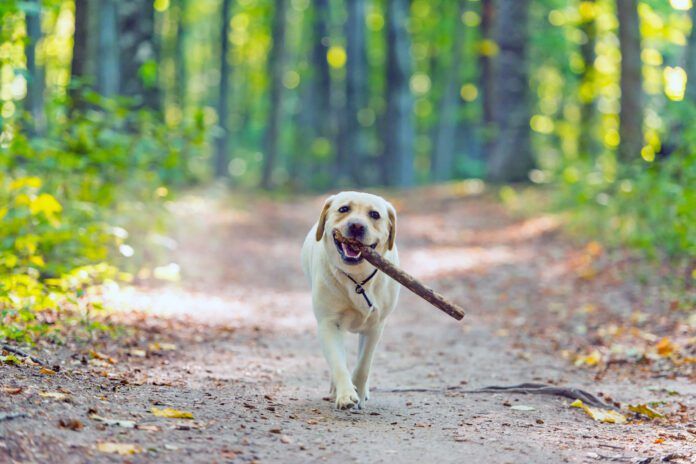
Many of us wonder how old our dog is in human years, sometimes using it as a gauge to decide how our dog must feel compared to our own aging bodies. The old standby is that one year of a dog’s life equals seven years in a human’s life. It’s easy to do mathematically, and it does give you a ballpark idea, but it’s no longer considered accurate, especially for younger dogs.
According to a 2020 study from the University of California at San Diego, the seven-year equation needed to be refined. Very simply put, the researchers used DNA changes to determine that a 1-year-old dog would be equivalent to about a 15-year-old person. This fits with puberty coming about that age for many dogs.
At the age of 2, the study showed dogs are comparable to around a 24- or 25-year-old human, a change of about nine human years.
After that, the USCD plan shifts to about five human years for each dog year.
However, there remains a discrepancy with toy breeds, who often hit 17 or 18 years of life, and giant breeds who are often elderly at 7 years or so. So, while this new method of calculating dog years into human years is based on scientific research, it doesn’t (yet!) compensate for the breed or size differentials in lifespans.
The Supporting Research
The USCD study included 104 Labrador Retrievers spanning a 16-year age range. The researchers scanned the dogs’ DNA patterns for comparison and used the rate of the methylation changes in the dogs to match it to the human epigenetic clock (biological aging). They then proposed a new formula of comparing dog years to human years for dogs over the age of 1. Much of the research on aging (in any species) looks at how DNA ages, particularly methylation, as this study did. The genes controlling this change in DNA appeared to be similar for both the Labrador Retrievers in the study and humans.
The study is fascinating, and you can access it as a beautifully illustrated report with charts of the study. The study conclusions were accepted by the American Veterinary Medical Association and most veterinary professionals support the findings.
The Dog Aging Formula
The study’s math is a complicated formula, requiring you to be able to calculate your dog’s age in natural logarithm (not how many years he’s been alive), multiplied by 16, plus 31. Using this formula, a 6-year-old dog would be equivalent to a human who is 59.7 years old, instead of the old method that would compare the dog to a 42-year-old human.
While most of us aren’t going to do the math, other examples of how this works out include a 7-week-old puppy being similar to a 9-month-old baby (with both of them teething at that age), and the average Labrador (who lives to about 12 years of age) correlating to a 70-year-old human (the Centers for Disease Control and Prevention say the average lifespan for humans is 76).
Health Matters to Dog Aging
An undisputed fact in lifespan calculations is that for all dogs – and humans, too, for that matter – keeping your dog fit, trim, and active, while practicing appropriate preventive health care and feeding good nutrition, is the best way to give your dog a long, full life. Of course, genetics do matter, so it helps to get a dog whose pedigree includes dogs who lived long lives, if you can obtain that information.
Dog Hot Spot Healing Stages
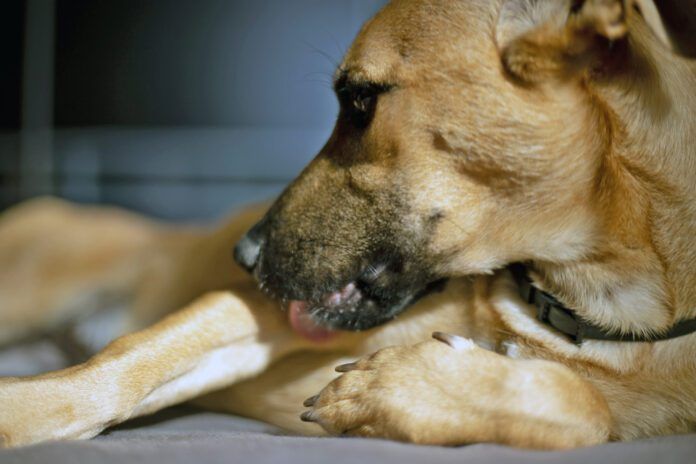
The healing stages of a dog hot spot start with when the spot is found on your dog’s skin. With treatment, a hot spot will be completely healed in about five days to two weeks. Hair growing back in over the spot can take several weeks longer. A hot spot—technically, acute moist dermatitis—occurs when your dog becomes obsessed with a sore or itchy or otherwise bothersome spot on his body and continually licks, scratches, and chews at it. The area becomes more painful, the more the dog licks and chews at it and infection is likely to set in.
Healing Stages of a Hot Spot
If you are lucky, the stages of healing a dog hot spot after it develops are:
- Hot spot discovered (day 1)
- Treatment begins (day 1)
- Daily improvement (day 2 through 5 to 14 depending on size and depth of hot spot)
- Completely healed (day 5 to 14 depending on size and depth of hot spot)
- Hair grows back (this can take several weeks after healing)
If your dog develops a hot spot and you are unlucky, the stages of healing are more drawn out:
- Hot spot discovered (day 1)
- Treatment begins (day 1)
- Hot spot worsens (day 2 to 4 depending on how long it takes you to get to the vet)
- Treatment plan adjusted by your veterinarian (day 2 to 4)
- Daily improvement (day 3 through day 7 to day 20, depending on size and depth of hot spot)
- Completely healed (day 7 to 20, depending on size and depth of hot spot)
- Hair grows back (this can take several weeks after healing)
What hot spot healing stages look like:
- Discovery: You will usually see a moist discharge in the hair surrounding the hot spot. There may be odor. The hot spot itself is red, raw, and oozing. You will notice your dog paying special attention to the area.
- Improvement: Every day the lesion appears a little drier, a little less red and irritated, more of a healthy pink, and your dog is less bothered by it. Eventually a scab may form, especially with deeper lesions. The scab will eventually fall off once skin is healed underneath.
- Completely healed: The skin will look normal, although hairless, and the dog will not be bothered by it.
Dog Hot Spot Treatment at Home
If you find the hot spot early and want to try a home treatment first, follow these important tips:
- Trim the hair. If your dog will tolerate it, trim or shave the hair over the hot spot and the surrounding hair. This allows for better visualization, more effective topical treatment, and better airflow to the wound.
- Use an antiseptic. Cleanse the wound with a wound cleanser containing an antiseptic like chlorhexidine. Rinse with warm water or saline and pat dry. Apply topical antibacterial ointment like bacitracin or triple antibiotic ointment and topical cortisone cream twice a day. An anti-inflammatory agent like cortisone is often necessary to break the vicious flame-itch-lick-scratch cycle. For those who prefer a more natural approach, topical apple cider vinegar is a decent anti-inflammatory agent and topical coconut oil has antimicrobial properties.
- Cleanse the wound daily. Gently clean the wound every day with saline before applying topical treatments, removing all seepage and residual ointment from the day before. Be sure no discharge is allowed to dry onto surrounding skin or hair as this will cause further irritation.
- Stop the licking. It is imperative that your dog not lick or scratch the hot spot! You must do whatever it takes or you will not win this war. Ongoing licking and/or scratching defeats treatment. Stopping your dog from getting access to the hot spot depends on where the hot spot is. Sometimes an Elizabethan collar or neck donut will work. Sometimes you can have the dog wear a clean, lightweight cotton T-shirt that you change daily. Adding a sock on the hind foot on the side of the hot spot can sometimes be helpful. Be creative. This step is critical.
If you are trying to treat your dog’s hot spot and it is getting worse instead of better, get to the veterinarian as soon as possible. Infected hot spots often require treatment with systemic antibiotics, not just topical. For some dogs, the inflammation and pain associated with the hot spot is so severe, it necessitates the use of oral steroids to break that nasty flame-itch-lick-scratch cycle.
Additionally, some dogs require sedation to get the area properly shaved and cleansed. Finally, bear in mind that your dog’s hot spot happened for a reason. Having your veterinarian diagnose and treat any underlying issues like allergies, ear infections, or flea infestation is imperative for successful healing of the current hot spot and prevention of future ones.
Types of Dog Tumors
Dog skin tumors can be benign or malignant, but they should all be inspected and not ignored. The Chase Away K9 Cancer community encourages you to carefully inspect your dog’s body once a month. They recommend the 14th of each month. By doing this monthly, you should be able to pick up any changes in lumps and any new lumps sooner than later. And sooner is almost always going to result in a better outcome.
If you find a new lump on your dog, ask your veterinarian to check it for you just to be sure it’s harmless. Mast cell tumors and malignant melanoma can look like a harmless mole, but they’re cancers that need treatment.
If your veterinarian says to keep an eye on it, note the size, color, and texture if possible. Write down what you see and take a picture of it. Then, when you check back in a month, you have an objective set of criteria to judge any changes. Report changes to your veterinarian. Cancerous lesions need treatment immediately, but even benign tumors may interfere with your dog’s quality of life if they become too big and cause problems with mobility.
Skin Tumor
Skin tumors can be some of the easiest masses to detect as they are superficial. These include sebaceous gland tumors and mast cell tumors. Internal tumors such as liver tumors or splenic tumors can be harder to detect. Your veterinarian may be able to palpate an abnormal size of these organs, but it can be difficult for owners.
Some lumps that turn out to be mast cell tumors can swell under your touch and turn red and warm. Other lumps may grow slowly and feel smooth. Many of those are benign fatty tumors or lipomas.
Name that Tumor
If your dog has had a biopsy done, the name of the removed tissue can give you an indication as to benign or malignant. Masses that end in “oma,” such as adenoma, tend to be benign tumors. Masses that end in “carcinoma” or “sarcoma” are generally malignant. The rule isn’t 100%, though, as lymphomas can be quite malignant, but it is a helpful guide.
Dog Behavior Change After Vaccination

Your dog just had his annual wellness exam and earned a clean bill of health. He also received vaccinations at that visit. Now your normally happy, playful pup just wants to sleep, is acting a little grouchy, and declined to eat his food. What happened?
Dogs can feel a little under the weather after receiving a vaccine. They may experience lethargy, a reduced appetite, pain or swelling at the vaccine injection site, or a low-grade fever. This is very similar to how many of us feel after being vaccinated. These side effects typically resolve within a day, but some dogs may experience these symptoms for up to three days after receiving a vaccine.
Some dogs may act weird or exhibit a temporary behavior change after receiving a vaccine. They may want to be left alone or might try to nip at someone that touches the site where the vaccine was administered. Think about the last time you or someone you knew got a vaccine in the arm; that spot is sore and tender for a few days. Dogs feel the same way but cannot say, “Hey! Don’t touch me there!”, so they may hide or nip.
Allergic reactions to vaccination
Lethargy, reduced appetite, and soreness are expected vaccine side effects. But a vaccine reaction – also referred to as an allergic reaction – is rare and always abnormal. Symptoms of a vaccine reaction include vomiting, diarrhea, facial swelling, hives, and severe coughing or difficulty breathing.
A vaccine reaction can occur in the first few minutes to a few hours after receiving a vaccine. Always seek immediate veterinary care if you think that your dog is experiencing a vaccine reaction.
The cause of a vaccine reaction is typically an allergy to one or more proteins used in the vaccine manufacturing process. For example, one method for manufacturing the influenza vaccine for humans is to grow the influenza virus in chicken eggs. These vaccines may contain a small amount of an egg protein called ovalbumin. This is why you may be asked if you are allergic to eggs before receiving the flu shot. If you answer “yes,” then you may be given a flu shot in which eggs were not used in the manufacturing process.
The same can be true for our dogs. Some canine vaccines are manufactured using fetal calf serum. These vaccines may contain trace amounts of bovine albumin, gelatin, and casein. A dog who is allergic to any of these proteins may experience an allergic reaction when given one of these vaccines.
How to minimize the risk of adverse events
If your dog experiences a vaccine reaction or is really bothered by vaccine side effects, here are some things you and your veterinarian can do to safely vaccinate your dog:
- Consider giving no more than two vaccines at one visit, and separate vaccine visits by at least two weeks. Small and toy breed dogs and dogs who are unusually sensitive to vaccines may benefit from only receiving one vaccine per visit.
- Dogs who have experienced a vaccine reaction may benefit from receiving an injection of diphenhydramine (Benadryl) with or without an injection of a short-acting steroid (like dexamethasone) just prior to receiving a vaccine.
- Since most vaccine reactions are caused by an allergy to proteins in vaccine growth medium, talk to your veterinarian about using an ultra-purified vaccine or a recombinant vaccine. Ultra-purified vaccines are taken through an additional purification process to remove more of the proteins that may cause an allergic reaction. Recombinant vaccines do not require a growth medium and are less likely to contain stabilizer proteins to which a dog may be allergic.
- You may think that giving only one-half the vaccine dose will minimize the risk of experiencing side effects. But the only thing this will do is provide your dog with inadequate protection against the disease being vaccinated against. Never give less than the manufacturer’s recommended dose of a vaccine.
Experiencing one or more vaccine side effects or having a vaccine reaction is not a reason to discontinue vaccinating your dog. Vaccines are an effective tool for preventing serious and sometimes fatal diseases. Talk to your dog’s veterinarian about the best vaccination plan for him.
Sidebar: How do vaccines work?
Your dog’s immune system (and yours, too!) is a sophisticated defense network that recognizes and neutralizes invaders that can cause disease, such as viruses and bacteria. The immune system has two parts: the innate system (also known as the general system) and the adaptive system (also known as the specialized system).
The innate immune system is the first line of defense but can only differentiate between friend and foe. The adaptive immune system is the second line of defense. It takes the time to learn about an invader and develop a strategy for neutralizing it. And it stores information about the invader should it ever enter your dog’s body again.
Before vaccines, the only way that the adaptive immune system could learn about its enemies was to be exposed to them through natural infection. This meant becoming ill with a disease – ideally, without dying – so that immunity could be developed by the adaptive immune system.
A vaccine introduces the adaptive immune system to a bacteria, virus, or toxin so that it can learn how to recognize that specific invader. Think of vaccines as training films for the immune system – like “Don’t take candy from strangers!”
Most vaccines are given as a series of two shots. The first vaccine shows the adaptive immune system how to recognize the invader. The second vaccine is like a simulation; it trains the adaptive immune system to make and store memories about the invader without launching an attack. If and when the real invader enters your dog’s body, the adaptive immune system will recognize and neutralize the virus or bacteria, preventing your dog from getting sick.
Histiocytomas in dogs
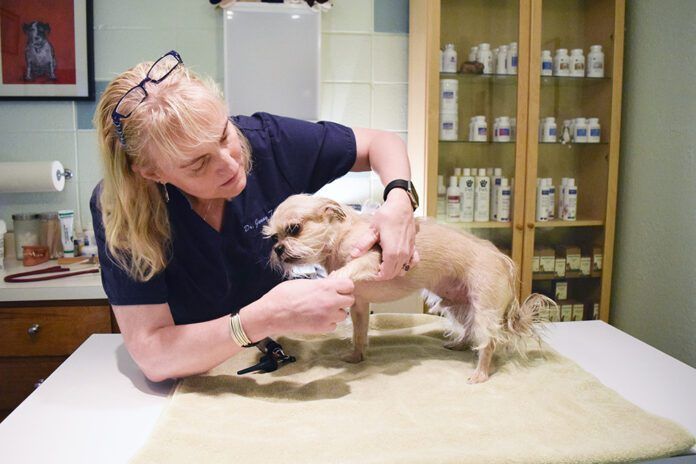
A cutaneous histiocytoma is a proliferation of cells involved with the immune system called Langerhans cells. Histiocytomas are skin tumors that are raised and hairless and may be flesh-colored, pink, or red. They often look like a small button on the skin.
These benign tumors that are most commonly found in dogs less than 6 years old. They initially grow rapidly over a period of one to four weeks. Then they often remain the same size until they spontaneously regress and disappear a few months later.
Histiocytomas are often readily diagnosed by fine needle aspirate and cytology. Because they can appear similar to mast cell tumors, it is important to complete this diagnostic to confirm the type of lesion. If the lesion is a histiocytoma, no further intervention is necessary. It will regress and resolve on its own.
(What if it’s not a histiocytoma? What else could it be? Click here.)
Most dogs leave histiocytomas alone and don’t bother them. But if your dog licks or scratches at a histiocytoma, it can become ulcerated and infected. Having your dog wear an Elizabethan collar (the “cone of shame”) and keeping the skin nodule clean and dry will often resolve the infection. A short course of an antibiotic may also be prescribed by your veterinarian.
Histiocytomas that continue to become infected or are not regressing on their own may need to be surgically removed by your veterinarian. This is typically a minor and straightforward procedure but it does require general anesthesia. Your dog will likely go home the same day that the procedure is performed.
For most dogs, the presence of a histiocytoma requires nothing more than monitoring until it resolves. It will often disappear almost as quickly as it initially appeared.
Why Dogs Lick Excessively
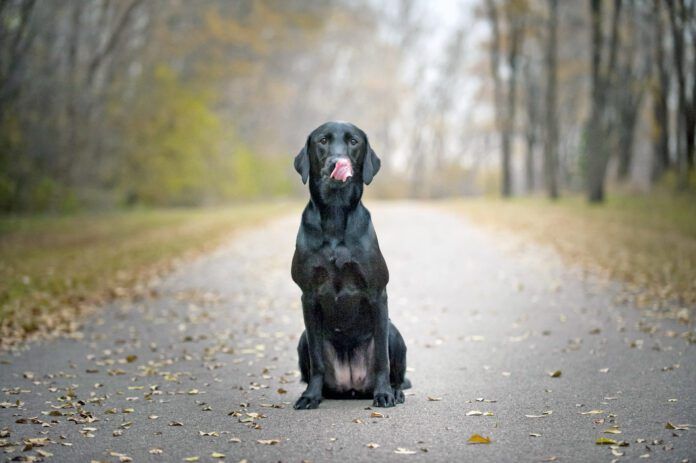
Dogs who lick their lips excessively may be suffering from anxiety, nausea, pain, oral disease, oral foreign body, or salivary gland disease. Or, they could just be smelling something yummy and licking their lips in anticipation (remember Pavlov’s dogs?). Still, boredom, compulsive behavior, and infection are all reasons dogs lick excessively.
Anxiety
Anxious dogs express their angst in different ways. Some scratch, some yawn, some tremble and tuck their tails, some whine, and some lick their lips repeatedly. Anxious dogs may excessively lick their skin to distract themselves from whatever is freaking them out. A veterinarian may be able to prescribe a medication to help your dog and offer ways to offset the dog’s anxiety.
Nausea
Nauseous dogs often drool excessively while their stomach feels off, before they eventually vomit. It’s natural for them to lick their lips when all that drool is dripping. A vomiting dog should be seen by a veterinarian if it doesn’t quickly resolve.
Bad Breath
If your dog excessively licks his lips and has bad breath, it’s time to look in his mouth. Dental disease –tartar, gingivitis, infection, periodontal disease, and loose teeth – can cause drooling and oral pain, both of which can result in excessive lip licking. Be sure to look at the roof of the mouth. When examining a dog for unusual lip licking, I have found a stick or a bone lodged across the roof of the mouth more times than I can count. The licking dog was just trying to dislodge it. If you suspect an oral problem, start with a visit to your veterinarian.
Allergies
Dogs who lick their skin excessively are usually suffering from allergies. Allergies in dogs frequently cause excessive licking of the paws. All that moisture can result in secondary yeast or bacterial infection of the skin there, which makes your dog want to lick there even more. Medications or dietary changes may be recommended.
Painful Joints
Dogs with arthritic joints will often spend time licking achy joints to try to soothe the pain. Your veterinarian can help you decide the best way to ease the inflammation and pain and help your dog. Librela is a new drug that is expected to soon receive FDA approval.
Boredom
Bored dogs may choose a spot to obsessively lick simply for something to do, sometimes to the point of creating a big sore called a lick granuloma.
Licking Owners
Dogs who lick their human’s skin may just be expressing affection. If you have recently applied lotion with coconut oil or shea butter, they probably just love how you taste.
If your dog is excessively licking and you can’t determine the cause or resolve it on your own, it’s time to see your veterinarian. Whether your dog is anxious, allergic, infected, nauseous or in pain, your veterinarian will help you keep your dog comfortable and living his best life
How To Train a Deaf Dog
Training a deaf dog requires patience and consistency, just as training a dog who can hear does. While replacing the verbal “sit” with a hand cue may seem odd to you, it’s normal for your dog. He’s been watching you all along. According to a 2018 study published in Animals, dogs naturally communicate with their bodies, as well as visual, tactile, acoustic, and olfactory signals.
Always have yummy treats ready for your training sessions, so you can capture and reward desired behaviors whenever they occur. Let’s start!
Teach Attention
All dogs need to be able to pay attention to their humans, but with deaf dogs, it’s critical. Because the dog can’t hear, training a deaf dog requires that he learn to look at you. Start with your dog on a six-foot leash.
This will take patience, but your dog will look at you. When he does, reinforce with a treat. Do this a half-dozen to a dozen times, and then end the session. You can repeat the session later. After he gets the idea that looking at you is the desired behavior, just give the attention cue and reward him when he looks at you.
You can train a “pay attention to me” cue, like pointing to your face, but if simply you treat each time he looks at you – consistently! – he will happily and frequently look at you, hoping it pays off with a yummy treat.
If He Ignores You
If your dog looks away too much, don’t worry. Just remember to reward him when he looks at you. To increase his attention, you can:
- Make vibrations. As you approach your dog, he may feel the floor vibrating and turn to look at you. If not, you may stomp your foot or hand on the floor to get his attention. Treat when he looks at you.
- Use a flashlight. Turning a flashlight on and off a few times should get your dog’s attention inside any time or outside at night. Do the light flashes inside near him first, so that you can give him a treat immediately after he looks at you. You want him to understand that’s the desired behavior. You can even use a porch light turned on and off to get attention at night. Caution using light sources though: Some dogs may develop OCD and compulsively chase the lights, especially lasers.
- Gently touch his shoulder or on his back above his tail. Before doing this, you need to condition him that this is a positive action so that you don’t startle him.
- Use a vibrating collar. This can be used to get your dog’s attention. The point is to communicate, not punish. Some dogs may be sensitive to the vibrations and become stressed. If so, use a different method to get his attention. Never use a shock collar, which is always aversive.
Hand Signals
You can use traditional hand obedience-competition signals: adapt some from American Sign Language, or make up your own. Dogs are experts at reading body language. Whatever you select, it’s crucial that you and everyone working with your deaf dog are precisely consistent in the signal used, including which hand is used. Each hand signal must be distinctive from the others.
When using hand signals, you can speak the word for the behavior cue. Even though the dog can’t hear it, you will probably be more natural if you simultaneously say the cue as you give the signal.
Use lure-reward training when teaching a cue using a hand signal. The dog will naturally follow the motion of the lure. “Sit” is a basic behavior to start with. Have a yummy treat in your hand and hold it just above your dog’s nose. Slowly move it toward the back of his head, then lift your elbow up toward a 90-degree angle. As soon as your dog’s posterior touches the ground in a sit, give him his reward treat.
In another training session, you can teach him to lie down on cue. Make a sweeping motion with a treat in front of his nose down to the ground when he’s sitting, luring him down. Treat and reward when his elbows come into contact with the ground.
Frankly, hand signals help any dog – with or without hearing – pay more attention to you. Even if your dog still has his hearing, many lose it as they age. And, just as with us, background noise can get in the way of the dog hearing a verbal cue. Plus – there may be times you can’t (or don’t want to) speak – like when you’re on the phone with a client.
Mark the Behavior
Since your dog can’t hear the traditional “good job” reward marker such as the click of a clicker or a verbal “Yes!” you need a different reward marker. This can be a thumbs-up, the action of clapping your hands, or even nodding your head a few times. And smile! Your dog will notice. Use your reward marker signal after he performs the desired behavior cue, then immediately provide him with his reward treat. Remember that every time you mark a behavior you must treat or provide some other high-value reinforcer.
If at any time your dog is reactive, aggressive, or you’re not making progress, get professional help before proceeding. Take your deaf dog to the veterinarian to be sure there aren’t any physical issues. You can also contact the International Association of Animal Behavior Consultants or the American College of Veterinary Behaviorists to find a behavior specialist in your area. If you need help with the training itself, you can contact the Pet Professional Guild or the Certification Council for Professional Dog Trainers.
Discontinued? Nooooo!
Things started devolving a few days ago, when I was busy watching my almost-2-year-old dog Boone chase a herding ball around my two-acre property. I had also been throwing Woody’s favorite ball with a Chuck-It, but the almost-8-year-old dog was panting hard, so I told him to take a break and left him laying in the damp grass with his ball. I bought a variety of herding balls to review a couple months ago, and Boone has developed some amazing skills at chasing his favorite – the 10-inch Virtually Indestructible Ball made by ht-pet.com.
It’s fun to watch Boone as he races all over the property, pushing the ball uphill, downhill, into the ditch that bisects our property (and turns into a tiny stream when it rains hard), out of the ditch, under bushes, and WHAM! – into fences, which he loves because he can chase it even faster as it rolls along a long fence line. He is getting fit and lean from all this exercise, and clearly has a blast doing it.
Finally, Boone rolled to a stop, panting, and plopped down on the ground near me, taking his own break. I turned around to see if Woody was ready for a few more throws and, to my dismay, realized that, while resting, he had chomped and chewed his favorite ball nearly to the point of no return.
Woody’s all-time favorite ball is the Orbee-Tuff Squeak Ball made by Planet Dog. It has all the features he likes in a ball: It’s made of a particularly bouncy material, but it’s hollow and fairly light-weight – but heavy enough to fly far when checked with a Chuckit! Ball Launcher. It floats, so we can play fetch at the lake. And it has a squeaker inside! – not one that can be chewed and removed, but molded as an integral part inside the ball. The ball will squeak when bounced hard on the ground, or when chomped between Woody’s mighty jaws – at least for the first month or two that he works on the ball. He likes to chew them like bubblegum as he returns from fetching, and if you let him wander away from you with one in his mouth, he’ll chew and chew and chew. (And rest with his lip draped over the ball, to maintain possession. And sometimes, he will even fall asleep with one in his mouth.)
Eventually, with enough unsupervised chewing, the squeaker will stop squeaking, and with even more unsupervised chewing, Woody can eventually cause the ball to crack. Then it’s a matter of minutes before he chews it into pieces. This process, complete with my somewhat distracted management, usually takes four to six months before I need to buy another one. There is ONE store in a nearby town that sometimes carries these, and when they have them in stock, I buy a couple. But I’ve also ordered many times from Amazon or Chewy.

Obviously, I try not to leave the ball laying around for Woody to chew. He doesn’t swallow the pieces, though if he did, that would (of course) be my main concern. Since he doesn’t swallow them, the sheer cost is my main problem to date. Replacing them even just two or three times a year adds up! I’ve probably spent hundreds of dollars on renewing our supply of these balls over Woody’s lifetime (Otto chewed up a few of these, too). And now, because of my inattention, I need to order one or two more.
Discontinued?!
So imagine my horror when I tried to add a couple to my next Chewy order and discovered they have none in stock.
I switched to Amazon – and the only ones they show as available are coming from a supplier in the United Kingdom, and are twice the cost that I usually pay. Ack!!

I went to the manufacturer’s website – and neither the blue nor the orange version of the ball is shown. I think it’s been discontinued!
A year or two ago, I noticed that the balls I bought didn’t smell or feel exactly the same as they always had. The maker, Planet Dog, had been purchased by another dog-toy maker, Outward Hound, and it seemed like the mold or the rubbery material used was slightly different, but only I noticed this; the change didn’t seem to bother Woody at all.
Given that even after the company’s sale, I was able to find the ball (and other favorite Planet Dog toys, like the Snoop, I went through the maker’s website again more slowly. Now I see that they are selling a pink ball with the same name – but what if the material is not the same? It might not have the chewy mouth-feel that Woody enjoys so much, and the bounce and flying ability that I love so much! I’ve ordered a couple – and Amazon shows that it will take a month to arrive! Noooo! I’ve also called a pet supply store in a nearby town (where I’ve bought the ball several times in the past) to see if they have any of the old balls still in stock. As I write this, I am waiting for a call back! If they have some, I am going to race over and buy every one they have!

Have one of your dog’s favorite toys or chews or other items even been discontinued? How did you cope? Did you find a replacement?
Why Do Dogs Roll on Their Backs?
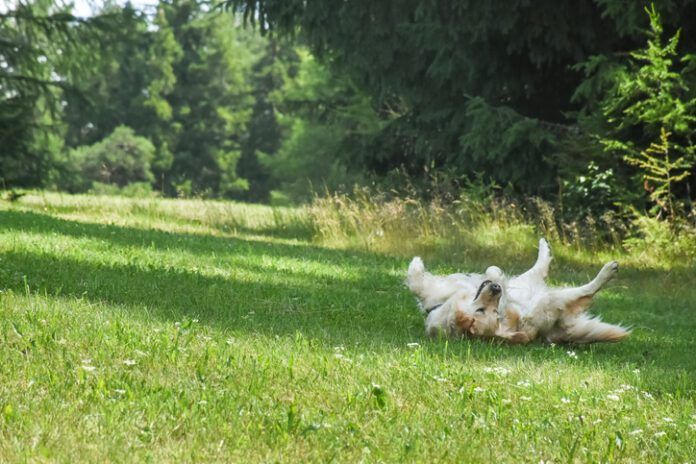
Why do dogs roll on their backs? A study published in a 2015 issue of Behavioural Processes determined that rolling over during play was a “combat maneuver adopted as part of an ongoing play sequence.” The researchers found the frequency of rollovers depended upon how long the play lasted. They considered none of the movements submissive, but instead, decided the dogs were either exhibiting defensive or offensive maneuvers during the play. This study debunks the idea that a dog rolling over, or showing their stomach to you or another dog, is a sign of submission.
We suspect there are a lot of reasons why dogs roll and, while behaviorists are amazing scientists, the dogs aren’t talking. One thing we know for sure – because dogs tell us with their body language and the above study says they saw it most during play – is that rolling feels good!
Dogs My Roll Because of Itchy Skin
Some dogs do roll because they’re trying to scratch an itch they can’t reach any other way. This is perfectly normal. The one thing we know for sure – because they tell us with their body language and facial expressions – is that it feels good to them, especially rolling in grass.
Excessive scratching, however, especially to the point of damaging the hair or the skin, could be a sign of a problem, such as fleas, ticks, parasites, pain, or an allergy. If that is the case, veterinary help is necessary.
Dog Roll to Hide Their Scent
Animal experts believe another cause of rolling goes back millions of years – to when dogs were wild and had to hunt for food. They roll in a scent other than their own to hide their own scent, so their prey won’t smell them as they approach.
And usually the smellier it is, the better it is. Other animals’ urine or feces, or even a dead animal, are best for the job of masking.
We know that dogs smell in layers, unlike humans. For instance, when we find a rose that smells like a skunk sprayed it, we only smell the skunk spray. But a dog smells the skunk spray and the rose.
Similarly, a dog can smell a tree that two or more dogs have marked with urine and identify those dogs. And when you see your dog sniffing the breeze, he’s identifying scents familiar and foreign, and dogs have an uncanny ability to smell things, which is one of the reasons they are such an asset in criminal investigations. Dogs enjoy scent, which may be one of the reasons scent games are increasing.
What Are the Best Dog Supplements?
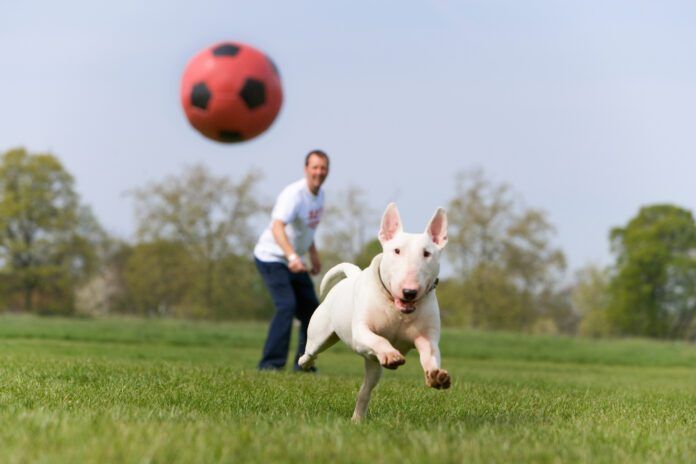
Supplements are a big buzzword for dog owners right now. You name the problem, and you can find a nutritional supplement for it. But does your dog really need a supplement? Except in the case of dogs battling arthritis and needing a joint supplement or some high-performance dogs, probably not.
Best Dog Hip and Joint Supplements
Joint supplements for arthritis have research behind their use. Glucosamine, chondroitin, Boswellia, omega-3 fatty acids found in fish oil, and avocado soy unsaponifiables (ASUs) have clinical backing. Best of all, research is ongoing in this area, so other substances like hyaluronic acid (HA), green-lipped mussels, and MSM are also being researched with promising results. Many canine products are being developed based on decades of research from equine and human supplements.
Joint supplements are expensive, and you do need to feed the amounts recommended or you are just wasting your money, including the required “loading period,” where you may have to give additional product in the first few weeks or so. Be sure to give the product a fair chance to show if it’s helping, which means keeping your dog on the product for at least two months.
Starting your dog on supplements sooner rather than later is wise. Supplements cannot reverse arthritis damage, but some research shows they can help delay its onset. Many owners of dogs who compete in canine sports begin supplementing their dogs early in their careers. For older dogs, in many cases, joint supplements can make your dog comfortable, help to minimize pain and to maximize mobility into your dog’s senior years. For some, however, the arthritis damange may be extensive enough that your dog may require pain medications to keep him active.
Choosing a Joint Supplement
Once you get finish your research and come up with helpful ingredients, you need to consider the many different supplement brands. The National Animal Supplement Council evaluates the products from its member companies to ensure that these supplements do contain what the labels state and to check that the company meets high standards of manufacturing and ingredients. Your veterinarian can guide you as well, but checking for a product with an NASC seal on it is still wise.
Other Nutritional Supplements
While joint supplements do have proven benefits for arthritis, if you’re feeding quality food with an AAFCO statement of nutritional adequacy on the bag that is appropriate for your dog’s life stage, your dog’s diet likely already covers any nutritional needs. Adding more is not always a good thing. You can even make your dog sick, as it’s important to consider what medications he is on and if there are potentially toxic interactions.
Ask yourself if there is evidence to back up any claims for the product you are considering. Look for a clinical trial or two that followed proper scientific protocols. Better yet, see if you can find one published in a peer-reviewed veterinary journal. Chances are, you can’t, except for joint supplements, as indicated. And always discuss nutritional supplements with your veterinarian.


